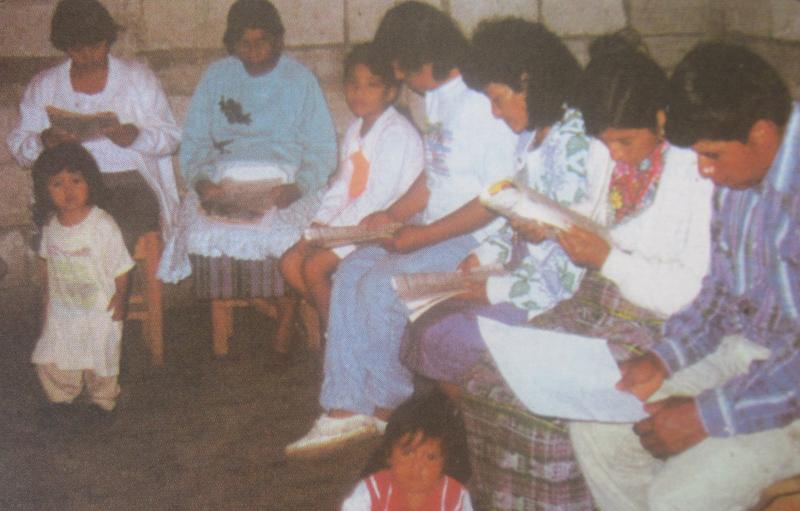A Taste of the World
By Fr. Rey Tejico, CICM
Like tribal people everywhere, the Mayan Indians of Guatemala are under siege from the Government, the military and intrusive lowlanders. Fr. Rey Tejico, a young Filipino missionary, tells us how the Church is trying, albeit belatedly, to respect and integrate the Mayan culture into the liturgy and to ensure that it enriches our Christian life.
The Chaos of Ignorance
When in 1992 our Province evaluated its missionary presence in Guatemala the decision was made to make a more radical commitment to pastoral missionary presence among the Indians. As a result of this decision a team of CICMers took up the task. We were convinced that we had given the right answer to the question: where is our presence as a missionary Congregation most needed in Guatemala today? The two places we chose were Aldea Lo de Fuentes and Tierra Nueva II.
Aldea Lo de Fuentes
Aldea Lo de Fuentes goes back to pre-Hispanic times, to the Poqomam culture. Forty percent of the population still use the Poqomam tongue and 60% of the women still wear their typical dresses. Aldea Lo de Fuentes is close to the capital. During the past two decades there have been major migrations of the Indigenous People toward Guatemala City in search of a better life. In Aldea Lo de Fuentes we find many different Mayan language groups: Kiche, Keqchi, Kaqchikel, Kanjobal, Ache, Awakatekos, Sakpultekos. This does not make things easy for us missionaries. Where in 1981 there were 660 Indian Families in Aldea, there now are 1442 (approximately 7,500 people). There are only a few Ladino families.
Tierra Neuva II
Tierra Nueva II is part of the municipality of Chinautla and is about 10 miles from Guatemala City. It’s population is close to 1000 families with an average of 5 members per family. This settlement is the result of a migration from rural areas which began in 1986 and continues today. In the past two decades the army has systematically y driven Indians from the rural areas to better able to control any insurgency.
Development Aggression
The peoples culture is important. We are doing our best to study and integrate the cultural values of the Mayan people into our ministry. Because the government’s development model for Guatemala is concentrated on the improvement of a few privileged people, there are many situations of social injustice and discrimination: a high rate of unemployment, large number of homeless people, serious problems in the fields of educations, health and nutrition. Many of our people live in harsh conditions. They have to work long hours at low wages. There is a lot of pressure from outside the community to abandon Mayan cultural values.
We want to connect our Church to the real life of the people. The Mayan culture has not yet disappeared from the map. They still have their own educational system which is built around the life and customs of the Mayan people. Its social order still has well-defined boundaries and values.
Respecting the Mayan Culture
We have developed a catechetical approach which respects the Mayan culture. We try to take into account their way of informal learning, formal initiations and rites and customs from within the Mayan culture in the past, the church failed to adopt Mayan customs and ritual. Today we are trying to make a special effort to learn the beauty of the Mayan religious customs and culture and to sue them in our liturgies and preaching.
Planting Rites
In May, we celebrated in Lo de Fuentes the May an rite of planting season, tx’opo’n a large number of people of all ages of Mayan origin and even two Mayan priests participated. The people themselves may not all have realized the significance of this celebration in the Catholic Church, but it was a beautiful experience, rooted in the life and culture of the people. There was Mayan music played on typical Mayan instruments.
For 500 years the Mayans have been celebrating the first rains and the planting season, asking special blessings from mother earth, thanking the Creator for all life, all gifts receive and asking for peace in the country. An altar is covered with white flowers and colorful candles. Each color has a special meaning. Green blesses the earth. Black appeases the evil spirits. Red is for love and romance. White stands for peace. Yellow for protection. In their prayers the Mayan priests ask for blessings from heaven. Some people think that the Mayan customs are on the decline and, indeed, some Indians in the urban settings do seem to lose interest in their traditions. But in our two missions many Mayan customs are still alive among the people.
Truly Mayan
As CICM missionaries we do want to help our people to integrate their culture into their religious practices and faith. We want to help this Church to become one that is truly Mayan and expresses the soul and heart of Mayan people in their religious rites and thinking.
Most of the poor Mayan families who settled in the slum areas as squatters were driven away by the military police. In order to pressure their government to give them protection they organized protest rallies, camping in front of the Palacio Nacional.
